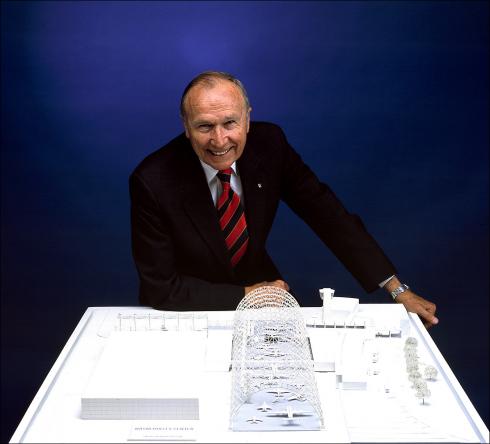
Donald D. Engen, 75, director of the Smithsonian's National Air and Space Museum, died in a motorized glider accident while vacationing in Nevada on July 13. Retired Vice Adm. Engen was flying with his friend and longtime pilot, William Ivans, when the glider crashed near Minden, Nev. He was a pilot for 57 years and had flown more than 7,500 hours in all types of aircraft, including his favorite, the glider.
Mr. Engen had served as director of the National Air and Space Museum since July 1996.
"Don has been a wonderful director," Smithsonian Secretary I. Michael Heyman said. "In only three years, Don has strengthened ties with the aviation community, brought popular exhibits to the public and been the guiding light behind the museum's new Udvar-Hazy Center. He also brought great management skills to the museum and, most important, a passion for flying and space exploration. He will be sorely missed at the Smithsonian."
During his tenure at the museum, Mr. Engen renewed relationships with civil and military aviation communities and continued extensive educational programs and exhibitions, including "Star Wars: The Magic of Myth," which was the most-visited exhibit ever at the Smithsonian. Mr. Engen's legacy to the museum undoubtedly will be his work on the Udvar-Hazy Center, an exhibition and restoration facility to be built at Washington Dulles International Airport in Virginia. He was involved in all aspects of the Dulles project, from hiring a fund-raising team to planning future exhibits.
In 1996, when Mr. Engen became director, the museum had about 7 million visitors. Last year, attendance was up to 10 million. What made the museum so popular with tourists during those years were new exhibitions ("Star Wars," "How Things Fly," "Business Wings" and "Space Race"), new IMAX films and many programs for families.
While Mr. Engen focused on the Udvar-Hazy Center, he also supervised the complete renovation of the museum on the Mall, a project that is being done in stages, at Mr. Engen's insistence, in order to reduce the inconvenience to visitors.
Mr. Engen had a long and distinguished military career before joining the Smithsonian, serving 36 years in the Navy and fighting in three wars. He was awarded 29 Navy decorations and awards including the Navy's highest honor, the Navy Cross, for his actions in World War II as a bomber pilot. He retired from the Navy as a Vice Admiral in 1978.
After he retired from the Navy, Mr. Engen became general manager of the Piper Aircraft Corp. plant in Lakeland, Fla. His civilian public-service career took off in 1982, when President Ronald Reagan appointed him to the National Transportation Safety Board. Two years later, he was named administrator of the Federal Aviation Administration, where he served until 1987. From 1987 to 1992, he was president and CEO of the Air Safety Foundation of the Aircraft Owners and Pilots Association.
Before he was appointed director, Mr. Engen held the Dewitt Ramsey Chair for Naval Aviation History at the museum.
In addition to his duties at the Air and Space Museum, he served on the Board of Directors of the Soaring Society of America, the Board of Governors and Executive Committee of the Flight Safety Foundation, and the Board of Directors and Executive Committee for the National Aeronautics Association.
Mr. Engen received many awards in his lifetime, among them the Society of Experimental Test Pilots' Doolittle Award for Technical Management (1984), the National Achievement in Aviation Award from the Aero Club of Washington (1988), and the National Aeronautics Association's Elder Statesman of Aviation.
The Soviet Union awarded him the Yuri Gagarin Gold Air and Space Medal in 1992, for his lifetime of work in aviation. And last year, the National Association of Aviation Officials awarded him their Honorary State Aviation Official award.
Mr. Engen was a graduate of George Washington University (1968) and he held a number of honorary degrees. He is survived by his wife, Mary; their four children; and seven grandchildren. Mr. Engen's family requested that donations be made in his memory to the Udvar-Hazy Center.
Mr. Engen became director of the National Air and Space Museum one year after his predecessor, Martin Harwit, resigned in the aftermath of the controversy about the exhibition of the Enola Gay, the B-29 that dropped the atomic bomb on Hiroshima.
Museum background
The National Air and Space Museum opened in July 1976. The most-visited museum in the world, it welcomed nearly 10 million visitors last year. The museum's collections include more than 30,000 aviation and space objects, including the Wright brothers' 1903 Flyer, Charles Lindbergh's "Spirit of St. Louis" and the Apollo 11 Command Module "Columbia." The Udvar-Hazy Center, a huge exhibition facility at Washington Dulles International Airport, is scheduled to open in 2003. It will become the home of the Enola Gay as well as spacecraft and airplanes such as the Concorde, all of which are too big for the museum on the National Mall.
The museum has 260 employees and an annual budget of more than $22 million.